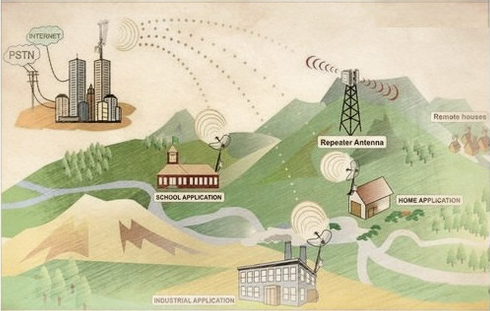Wireless bridges, like wireless APs, are wireless transmission devices. The difference is that wireless APs are used for wireless coverage (WiFi), and wireless bridges are used for video monitoring (wireless monitoring). The following is a detailed introduction of wireless bridge-based monitoring system knowledge by transmission product & service provider Feng Runda.
First, what is a wireless bridge
A wireless bridge is a bridging device of a wireless network. It uses a wireless transmission method to establish a bridge between two or more networks and can transmit data of one network to another.
In wireless monitoring, the wireless bridge acts as a network bridge for the transmission of wireless surveillance video signals, and is equivalent to a suspended invisible network cable, thereby eliminating the need for wiring (network cables) in this section, making the construction of the project easier.
Wireless bridges cannot be used individually. They need to be used in pairs or one-to-many. There must be a transmitter and a receiver to complete the complete transmission of wireless data.
Second, wireless bridge in the wireless monitoring of several applications
1, point to point application
Peer-to-peer is a launch point corresponding to a receiving point, which is a one-to-one use of a wireless bridge, which is also the simplest way of networking. The two-point antenna must be oriented relatively to achieve the best results.
This method is suitable when there are no obstacles, there are few obstacles or the visual distance is relatively close. In the transmission process of this method, the loss is minimal, and the monitoring data transmission effect is the best. If it is an analog camera, this method can only be used.
   2, relay mode
This is an indirect transmission method that requires a wireless bridge to act as a "repeater", typically used for wireless transmission between two buildings that are not directly visible, or that has obstructions (indirectly bypassing obstructions) transmission.
As shown in the figure below, the signal needs to be transmitted from point A to point B, but there is a building (C) blocking between them, and you do not want to change the other route. You can then install a wireless bridge in this building. A The signal at the point is first transmitted to C and then transmitted to B, which is equivalent to one more step in the middle.
Since there are certain losses in the signal and transmission in this mode, use the relay mode as little as possible, or use the case where the transmission bandwidth is not high and the distance is short.
3, point-to-multipoint applications
This networking mode is used in wireless monitoring and must be a network camera. Multiple transmitters correspond to one receiver. For example, there are multiple wireless bridges at the front end to transmit monitoring data from multiple surveillance cameras, and then converged to the receiver's wireless bridge for unified transmission to the monitoring center.
This method is suitable for network monitoring. It should be noted that the angle between the two transmitters should not be too large. Usually, the angle between the two transmitters should be kept at about 20 degrees. The transmission distance between the transmitter at the front end and the receiver should not be too far. It is better to ensure that the transmission link is the same. Only one line can guarantee the stability of the transmission picture quality; the pixels of the camera used should not be too large.
When using the point-to-multipoint mode, pay attention to several points: the transmission distance, transmission bandwidth, and the transmission channel are unimpeded. Of course, you also need to flexibly select the bridge equipment according to the site conditions.
Third, wireless bridge application environment
Wireless bridges are usually used outdoors, mainly for connecting two networks, wireless bridges used in pairs, one as a transmitting end, and one as a receiving end, transmitting data through the air.
When doing monitoring projects, the problems of cable pulling and wiring cannot be avoided. If the monitoring scope is not large, the monitoring points are relatively centralized, and the wiring is relatively simple, the general cable monitoring will not have much difficulty. If the monitoring area is large, the points are scattered, and it is inconvenient to pull cables (forests, reservoirs, mining areas, etc.), cable monitoring will also be a headache. Using a wireless bridge to set up wireless monitoring is much simpler.
When using wireless bridges outdoors, you need to pay attention to the environment, antennas and other issues. The greater the transmit power of the antennas, the farther the transmission distance. A pair of 12dbi directional antennas can achieve 2km of point-to-point microwave interconnections, and 27dbi of directional antennas can achieve 10km of point-to-point microwave interconnections.
Fourth, the characteristics of wireless bridge-based monitoring system
Wireless bridges have taken wireless technology to a new level and are widely used in wireless surveillance projects. Using a wireless bridge to establish a wireless monitoring network, deployment personnel will be able to obtain a very flexible and easy-to-use solution. Compared with wired monitoring, wireless monitoring has been widely used due to its advantages such as easy installation, no restriction on wiring, and cost saving.
1, high flexibility
Now security requires no deadleg video surveillance, wireless monitoring is not limited by cables, has flexible scalability, can easily add new monitoring points at any location, and can change the location of the old monitoring, increasing the location uncertain Sex, so that the real implementation of security monitoring.
2, low cost
Only a one-time investment is required, and the wiring cost is low. There is no need for a professional construction team and no need to dig trenches. Wireless monitoring can get rid of the shackles of cables. It has the advantages of short installation cycle, easy maintenance, strong capacity expansion, and rapid cost recovery.
3, short construction period, easy maintenance
Wireline monitoring is often limited by the geographical environment and working environment, the construction period is very long, and even some areas of the wiring project simply can not be achieved. At this time, wireless monitoring was adopted to fundamentally free the cables and install them flexibly.
4, a wide range of applications
Can be widely used in a wide range of distributed safety monitoring, traffic monitoring, industrial monitoring, home monitoring and other fields. Such as ATMs, bank tellers, supermarkets, factories and other wireless monitoring, nursing homes, kindergartens, schools to provide remote wireless monitoring services.
At present, wireless bridges have been widely used in the field of security monitoring. For example, Fengrunda wireless bridge has many successful projects, such as Anyang Tangyuan Yiyuan International Community elevator wireless monitoring, Henan provincial government wireless monitoring and so on. With the continuous enhancement of security requirements, wireless bridges play a very important role in the development of monitoring systems.
We have made Truck Crane for many years of load capacity
ranging from 2 to 20 tons. Its working radius and lifting height will change
with the load capacity. You can select different truck such as DONGFENG or JAW
or other brand as you like. Our Truck Crane products has the following feature:
1. Quality manufacturing for reliable
performance hour after hour.
2. Easy maintenance access and
corrosion-protected electrical connectors keep downtime to a minimum




